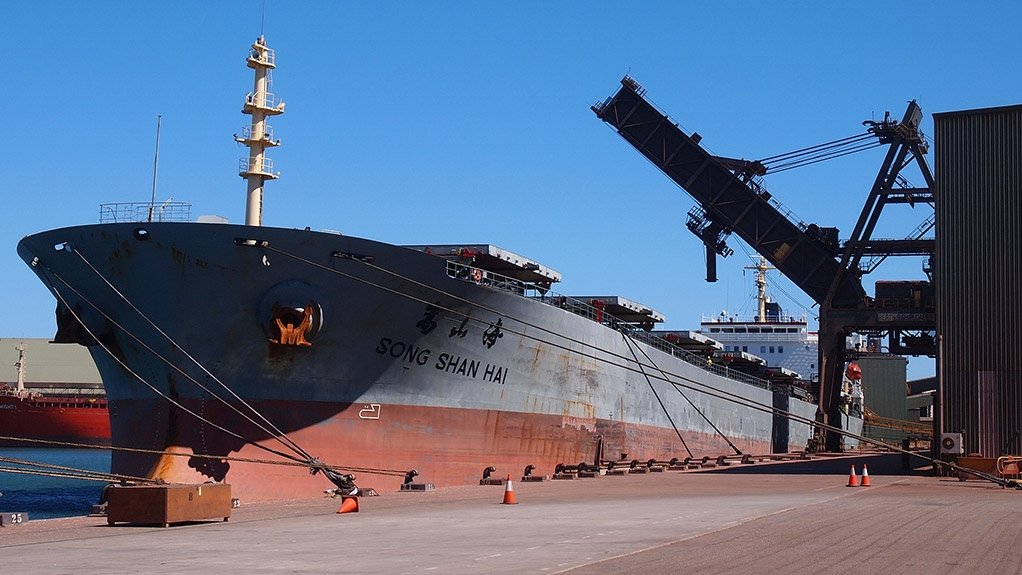PERTH (miningweekly.com) – The value of Australia’s resources and energy export earnings for 2016/17 has been upwardly revised by A$12-billion since December last year, to A$215-billion.
The Office of the Chief Economist said on Friday that the upward revision largely reflected the unexpected increase in iron-ore prices, as well as the unexpected strength in thermal coal prices during the March 2017 quarter.
Export earnings for 2017/18 have also been upwardly revised by A$17-billion, stabilising at A$215-billion, owing to the increase in iron-ore, metallurgical coal and thermal coal prices.
As a result of the revisions, 2016/17 and 2017/18 are expected to represent the highest level of resources and energy exports both on record and over the outlook period.
In its latest quarterly report, the Office of the Chief Economist noted that, over the next two years, export volumes will continue to grow for iron-ore, base metals and coal, but the most important source of growth will be liquefied natural gas (LNG). Australia’s LNG export volumes, which grew by nearly 50% in 2015/16, are forecast to double in the next three years, as new production capacity comes fully online.
LNG is also forecast to displace metallurgical coal to become Australia’s second-largest commodity export in 2017/18. Following large investment in new production capacity, Australia’s LNG exports volumes are projected to grow by 106% between 2015/16 and 2018/19.
Iron-ore export earnings are forecast to increase by 49% in 2016/17, to reach a three-year high of A$72-billion, supported by the extended rally in the iron-ore price. Export volumes are forecast to grow by 8.2% to 850-million tonnes, supported by output growth from ongoing productivity improvements and capacity expansions.
Australia’s iron-ore exports are forecast to increase by 8.3% and 3% in 2017 and 2018, respectively, before growing at a slower pace to reach 917-million tonnes in 2022.
Australia’s metallurgical coal export volumes in 2016/17 are forecast to increase by 1.9% to 192-million tonnes, underpinned by increased import demand from China, the report predicted.
Export values are forecast to increase by A$16-billion to A$37-billion, supported by higher volumes and five–year record high prices. In 2017/18, metallurgical coal export volumes are forecast to increase by a further 1%, to 194-million tonnes, supported by rising steel production.
Metallurgical coal export values are forecast to decline by 12% to A$32-billion in 2017/18, as prices come off late 2016 and early-2017 highs.
Export volumes for thermal coal in 2016/17 are forecast to increase by 0.4% year-on-year to 202-million tonnes. Higher export volumes are likely to be supported by higher production, driven by China’s strong demand, notably in the first half of the year. Export earnings are forecast to increase by 28% year-on-year to A$18.9-billion, driven by increased spot thermal coal prices.
Meanwhile, with the limited number of mining projects currently in the investment pipeline, it is unlikely that in the five-year outlook period the value of resource and energy exports will increase substantially beyond 2018/19.
Export volumes, primarily of LNG, are projected to continue to increase until 2018/19, but this is projected to be offset by declining iron-ore and coal prices. Growing low-cost supply and subdued global demand growth are expected to weigh on iron-ore prices, while coal prices will come under pressure as China implements fewer cuts to capacity.
The Association of Mining and Exploration Companies (AMEC) said on Friday that the upward revision of the export earnings forecast showed that Australia continued to benefit from investment made by the mining sector over the last ten years.
“Higher iron-ore and metallurgical coal prices have been a key driver of this revision. Iron-ore prices reached an unexpected 30-month high of $89/t in mid-February 2017. Australian iron-ore exports are forecast to have increased by 50% in 2016/17, to reach a three-year high of A$72-billion,” AMEC CEO Simon Bennison noted.
“Because of the large investment to boost production capacity in the past decade, recent extensive cost-cutting and the high quality of Australia’s resources, export earnings from mining are forecast to remain high.
“The growth in global demand for “non-energy resource commodities” such as iron-ore, gold, aluminium, copper, nickel and zinc, is projected to be slower than in the previous five years, with the Office of the Chief Economist predicting that, while remaining significant, the rate of Chinese urbanisation will taper in the next five years.”
However, Bennison pointed out that India is predicted to expand its steel production and overtake Japan as the world’s second-biggest steel producer, saying that with the correct public policy settings, Australia could position itself to take advantage of these opportunities.
Edited by: Chanel de Bruyn
Creamer Media Senior Deputy Editor Online
EMAIL THIS ARTICLE SAVE THIS ARTICLE
ARTICLE ENQUIRY
To subscribe email subscriptions@creamermedia.co.za or click here
To advertise email advertising@creamermedia.co.za or click here













